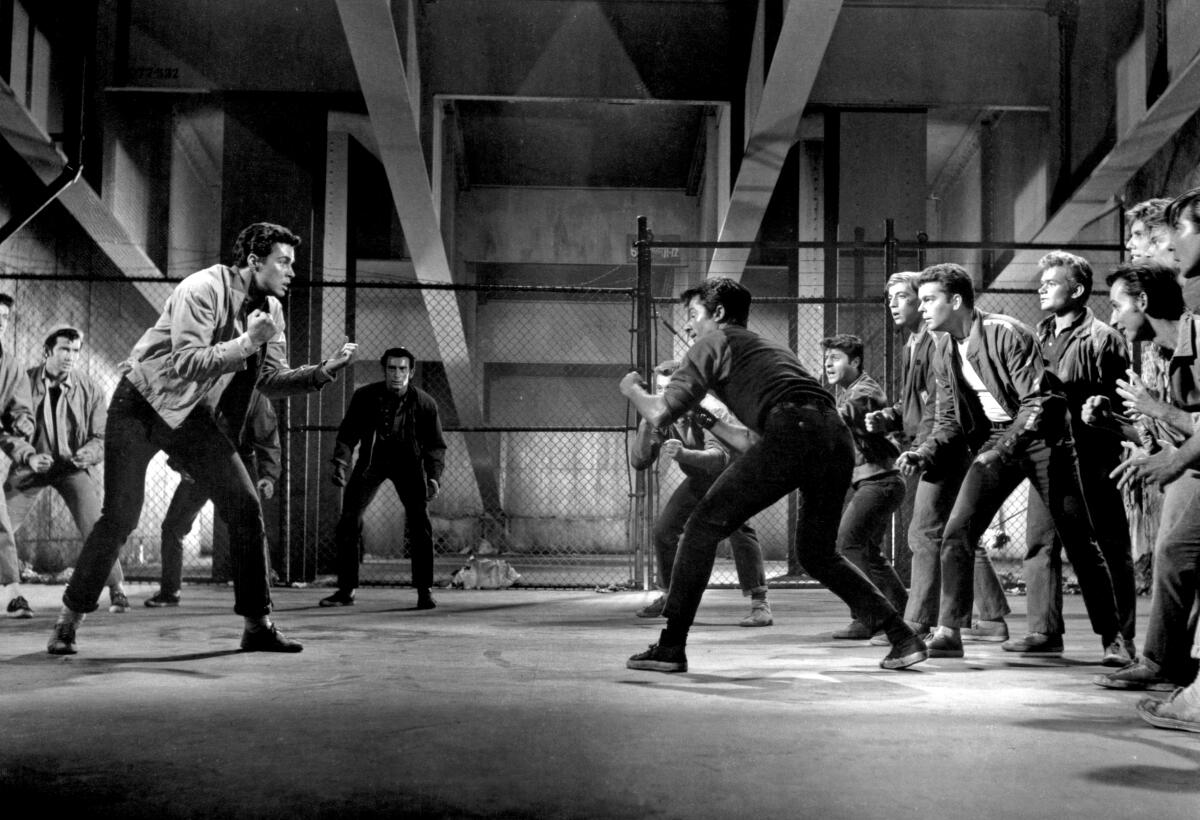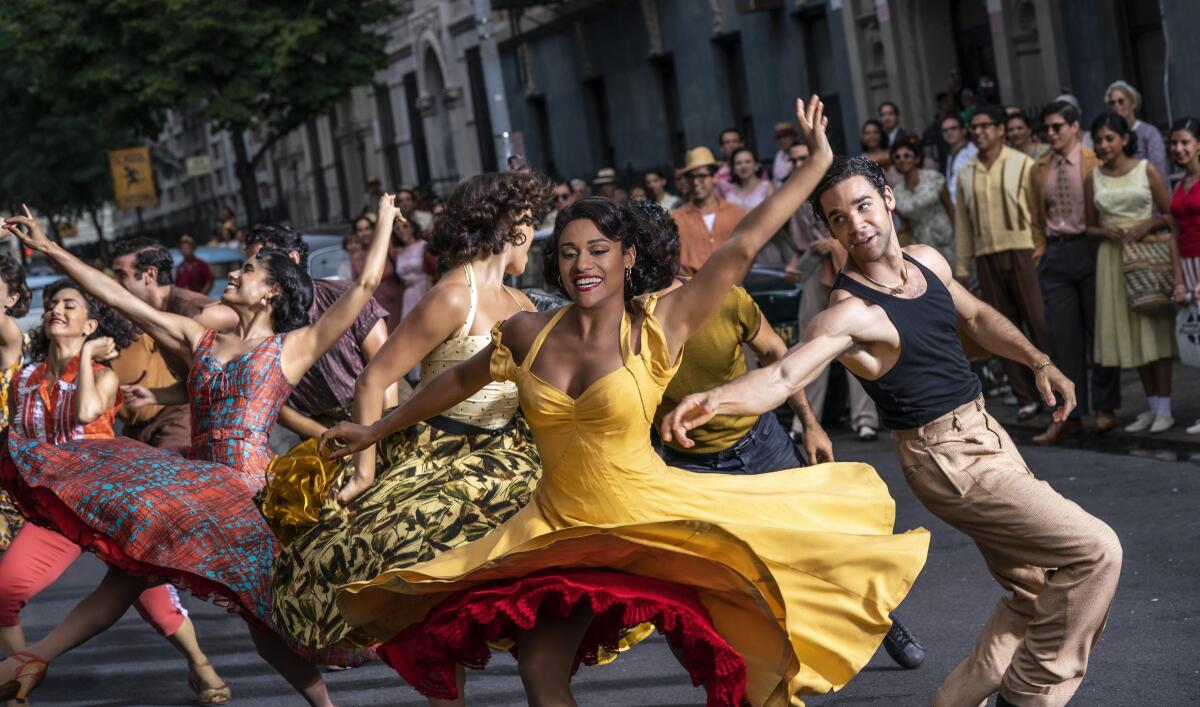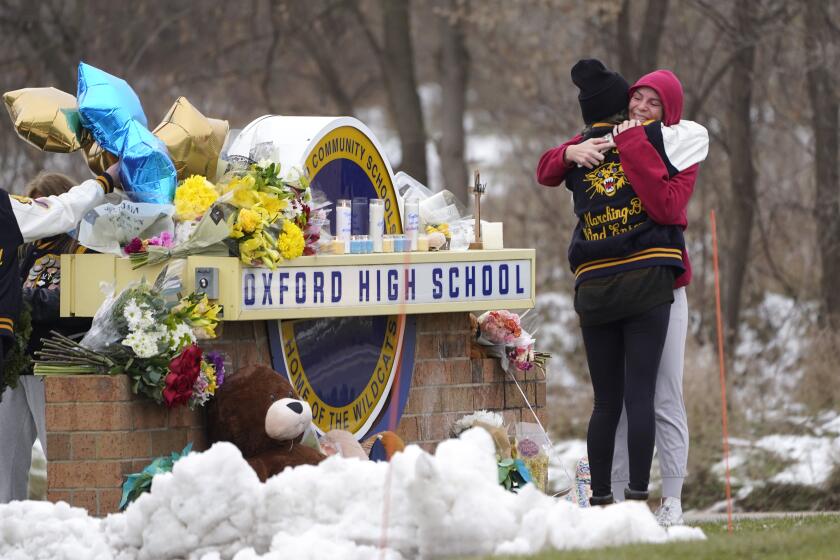Op-Ed: The real cultural significance of ‘West Side Story’? It spread powerful myths about gangs

- Share via
Many enduring myths about gang membership can be traced to the Oscar-winning movie musical “West Side Story,” released in 1961. The tale of love and war between two gangs popularized many fictions, including the notion of “once a gang member, always a gang member” and the idea that gangs operate like formal organizations.
On Friday, these themes may be reintroduced in pop culture when Steven Spielberg’s remake of the film opens in theaters. The original has been heralded as one of the greatest musicals of all time. It won 10 Academy Awards, including best picture, and was deemed “culturally significant” by the Library of Congress.
Yet, for criminologists like us, “West Side Story” is better known for its romanticized and racialized depictions of youth gangs. It is culturally significant largely because it helped source and spread some of the most powerful and pervasive myths about gangs. Myths that inform public opinion and public policy on gangs and myths that, for years, our research has sought to challenge.
No child kills in a vacuum. The decision to charge the Oxford High suspect’s parents might spark legislation to get troubled youth the help they need.
After interviewing hundreds of gang members on the streets, in schools and in jails and prisons, we can say that the truth about gangs is largely missing from this period piece.
For instance, one of “West Side Story’s” more famous statements on gang life is found in this lyric: “When you’re a Jet, you’re a Jet all the way, from your first cigarette to your last dyin’ day.” That gang membership is a lifelong commitment is an enduring Hollywood trope and underlying assumption of many real-world responses to gangs, which includes gang databases with no sunset clauses and sentencing enhancements for gang members that can tack on 10 years to a prison sentence.

Research shows gang careers are in reality rather brief — about two years long on average. This matters because intervening in the life of someone you believe has the capacity to change is simply different from believing someone is beyond redemption.
In the “West Side Story” song “Gee, Officer Krupke” the gang mocks the police officer and criminal justice professionals, psychologists and social workers who treat them as abnormal and make excuses for the gang’s delinquency. The message: Gang members are willful transgressors of the social order and for that reason therapy and social service provisions won’t work; only punishment and prison time will. Police gang units and their suppression tactics feel like a natural response to this myth, when in fact studies find community responses to gangs and, yes, even therapy, have been shown to better curb gang crime.
In “West Side Story,” the gangs spend most of their time planning or committing crimes. Gangs in real life don’t. Life in the gang is far duller than depicted in popular culture — in this film and in others where gang members are the central protagonists. As one researcher put it after observing actual gangs at length: “For the most part, gang members do very little — sleep, get up late, hang around, brag a lot, eat again, drink, hang out some more. It’s a boring life.”
The gangs in “West Side Story” are organized. They meet to negotiate the terms of a fight. They set rules and appoint roles. They vote. This myth of the gang as a formal organization explains why the Racketeer Influenced and Corrupt Organizations Act is still the weapon of choice for prosecutors looking to disrupt and dismantle criminal groups from the top down.
The CalGang database isn’t a law enforcement tool. It’s a driver of mass incarceration.
But the reality is most gang structures are horizontal, not vertical. Leadership is fluid. Membership is dynamic. People in gangs come and go and many leave simply by walking away. This was true of gangs on the street and many gangs in prison in the 1960s and it remains true today.
“West Side Story” offers an ageless critique of racism and blocked opportunity in America. “Life is all right in America, if you’re all-white in America,” the Puerto Rican gang members sing. At the same time, the movie perpetuates the myth of interracial gang violence.
The Sharks are Latino, the Jets are white, and racism is the central organizing feature of their hatred for one another. But in reality, most gang violence occurs within racial or ethnic groups, not between them. Members of a gang compete for prestige, standing, distribution of illegal goods and the affections of members of the opposite sex.
“West Side Story” also promotes the myth of gangs as a male-only preserve, but that’s just not true. In the film, women are peripheral figures, girlfriends and tomboy buddies who must prove their worth to men. Adherence to these same gender stereotypes today renders female gang members vulnerable to male exploitation and less visible to gang prevention and intervention programs.
The original “West Side Story,” directed by Jerome Robbins and Robert Wise, did get some things right, including how many of the consequential decisions gang members make in life are based on limited information, gossip and rumor.
In actuality, gang members are consummate myth-makers, and in the film, like on the streets, people can lose their lives because they believe the hype of faulty narratives. One of those narratives is that gangs offer protection. While gang membership may reduce perceived risk of violent victimization, research shows that actual risk of injury or death increases dramatically in gangs, and the film bears this out.
Spielberg’s reimagined film could end up reviving cultural interest in gangs. If that occurs, may it be grounded in a reality that leads policymakers to design gang responses based on fact and not fiction.
James Densley is a professor of criminal justice at Metropolitan State University. David Pyrooz is an associate professor of sociology at the University of Colorado in Boulder. Scott Decker is a professor emeritus in the School of Criminology and Criminal Justice at Arizona State University. They are authors of the forthcoming book “On Gangs.”
More to Read
A cure for the common opinion
Get thought-provoking perspectives with our weekly newsletter.
You may occasionally receive promotional content from the Los Angeles Times.












